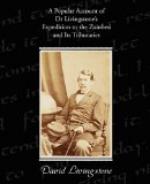Fruit-trees and gigantic wild fig-trees, and circles of stones on which corn safes were placed, with worn grindstones, point out where the villages once stood. The only reason now assigned for this fine country remaining desolate is the fear of fresh visitations by the Matebele. The country now slopes gradually to the west into the Makololo Valley. Two days’ march from the Batoka village nearest the highlands, we met with some hunters who were burning the dry grass, in order to attract the game by the fresh vegetation which speedily springs up afterwards. The grass, as already remarked, is excellent for cattle. One species, with leaves having finely serrated edges, and of a reddish-brown colour, we noticed our men eating: it tastes exactly like liquorice-root, and is named kezu-kezu. The tsetse, known to the Batoka by the name “ndoka,” does not exist here, though buffaloes and elephants abound.
A small trap in the path, baited with a mouse, to catch spotted cats (F. Genetta), is usually the first indication that we are drawing near to a village; but when we get within the sounds of pounding corn, cockcrowing, or the merry shouts of children at play, we know that the huts are but a few yards off, though the trees conceal them from view. We reached, on the 4th of August, Moachemba, the first of the Batoka villages which now owe allegiance to Sekeletu, and could see distinctly with the naked eye, in the great valley spread out before us, the columns of vapour rising from the Victoria Falls, though upwards of 20 miles distant. We were informed that, the rains having failed this year, the corn crops had been lost, and great scarcity and much hunger prevailed from Sesheke to Linyanti. Some of the reports which the men had heard from the Batoka of the hills concerning their families, were here confirmed. Takelang’s wife had been killed by Mashotlane, the headman at the Falls, on a charge, as usual, of witchcraft. Inchikola’s two wives, believing him to be dead, had married again; and Masakasa was intensely disgusted to hear that two years ago his friends, upon a report of his death, threw his shield over the Falls, slaughtered all his oxen, and held a species of wild Irish wake, in honour of his memory: he said he meant to disown them, and to say, when they come to salute him, “I am dead. I am not here. I belong to another world, and should stink if I came among you.”
All the sad news we had previously heard, of the disastrous results which followed the attempt of a party of missionaries, under the Rev. H. Helmore, to plant the gospel at Linyanti, were here fully confirmed. Several of the missionaries and their native attendants, from Kuruman, had succumbed to the fever, and the survivors had retired some weeks before our arrival. We remained the whole of the 7th beside the village of the old Batoka chief, Moshobotwane, the stoutest man we have seen in Africa. The cause of our delay here was a severe attack of fever in Charles Livingstone.




